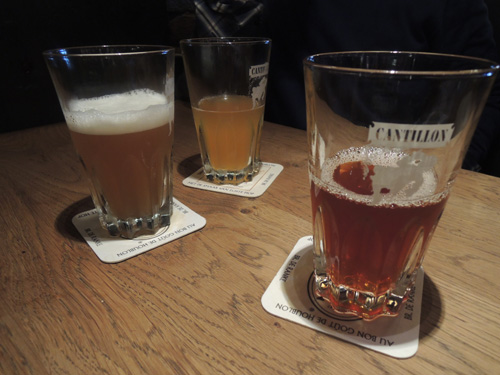
by Mark Meli
Lambic is a category of beer made in the Payottenland area of Belgium around Brussels. It is spontaneously fermented in wooden barrels by wild yeast living in that area. Many breweries around the world, including in Japan, brew beers called “lambic,” but like authentic Champagne, which must come from the Champagne area of northern France, authentic lambic must be brewed in this area of Belgium.
Lambic is usually brewed from 30% unmalted wheat, along with malted barley. Furthermore, although hops are used as a preservative, the usual hop aromas are thought to clash with the sour, “funky” character that comes from spontaneous fermentation, so only old, dried-out hops with little flavor are used.
Once the wort is boiled, it is placed in a “coolship:” a shallow, wide pool, were it is exposed to wild yeasts, the most important of which is Brettanomyces bruxellensis. The wort is then transferred to oak barrels, wherein various other yeast and bacteria also set to work fermenting it.
In Belgium, it is possible to drink unblended lambic, young or old, straight from the cask. Most people, however, will drink it in one of 2 ways, as Gueuze, which is a blend of different-aged beers (usually year-old lambic blended with 2, 3, or 4 year-old), or as fruit lambic, such as Kriek, which is produced by adding fresh fruit to the barrels.
Gueuze is dry, with minimal sweetness. It may range from slightly tart and lemony to intensely sour, but will always show a funky “horse blanket” character from the wild yeasts. There may be flavors of leather, hay, old books, and yogurt as well. It is often shocking to people who try it for the first time. Fruited lambics will have similar characteristics, but will also show rich fruit aromas and flavors. Even so, they are usually not sweet.
When selecting lambics, the key is to look for Oude (Old) Gueuze or Kriek. The appellation “Oude” signifies 100% lambic beer, unmixed with non-lambic beer, and if fruited, only whole fruit is used—no syrups or sweeteners. The brands of lambic most easily found in Japan are not “Oude.” In fact, most of the lambic produced today is a sweet, fruity drink with little authentic character—don’t bother. Lambic from all the authentic breweries can be found in Japan if you search hard enough. Look for the “Oude,” and I suggest you try them at first with cheese and rustic bread, which they go with perfectly, and which may render them less shocking.
All Beer Styles articles are written by Mark Meli, author of Craft Beer in Japan.
This article was published in Japan Beer Times # () and is among the limited content available online. Order your copy through our online shop or download the digital version from the iTunes store to access the full contents of this issue.



